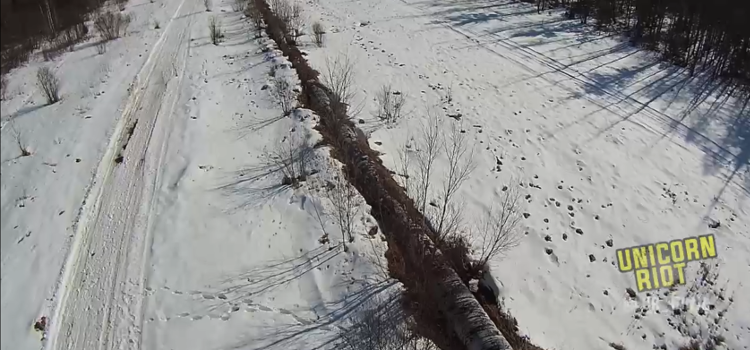Trump Pushes Forward DAPL & KXL Pipeline Approvals; Resistance Continues
Oval Office / Washington, D.C. – On January 24th, 2017, President Donald Trump signed two memorandum in hopes of pushing forward the construction of the Dakota Access Pipeline & the Keystone XL Pipeline. Following the announcement, protests took place across the United States. Thousands took the streets from New York City to Los Angeles, as news of the memos pushing forward two pipeline projects spread and alerted a massive organized resistance.
The quick response came as fears that the Trump’s administration would push forward pipeline projects by some means, most assumed executive orders, he went with Presidential Memoranda.
to everyone who marched last weekend – we need you to show up for #NoDAPL https://t.co/H69nBreKDl
— Katy Stoll (@katystoll) January 24, 2017
The memoranda are still executive directives, but hold less weight than an Executive Order (EO), and usually used to provide directives to federal institutions. In this case, Trump’s memo to the Secretary of the Army advised them to expedite the process of approving the pipeline.
Sec. 2. Directives. (a) Pipeline Approval Review. The Secretary of the Army shall instruct the Assistant Secretary of the Army for Civil Works and the U.S. Army Corps of Engineers (USACE), including the Commanding General and Chief of Engineers, to take all actions necessary and appropriate to:
(i) review and approve in an expedited manner, to the extent permitted by law and as warranted, and with such conditions as are necessary or appropriate, requests for approvals to construct and operate the DAPL,
The full language of the memorandum pushes forward the Dakota Access Pipeline (DAPL) project, but does not eliminate the intent of Environmental Impact Statement (EIS) by the Army Corp, and does not grant the final easement necessary for the pipeline to cross the Missouri River.
The memo asks the head of the Army to tell the Army Corps that they should look to see if it is legal for them to cancel their intent to do an EIS.
and whether to withdraw the Notice of Intent to Prepare an Environmental Impact Statement in Connection with Dakota Access, LLC’s Request for an Easement to Cross Lake Oahe, North Dakota, dated January 18, 2017, and published at 82 Fed. Reg. 5543;
But according to the language in the memo, they are still required to follow the laws before taking actions to move forward on the Dakota Access Pipeline.
The DAPL memo was signed alongside a memo that addressed the Keystone XL Pipeline (KXL).
The Keystone XL memo asks TransCanada to reapply for a permit to build the Keystone XL Pipeline with a promise of presidential approval, and demands that the federal institutions involved expedite the permitting process, even promising TransCanada a turn around of 60 days once the application is resubmitted.
Sec. 3. Directives. (a) Department of State. The Secretary of State shall, if the application referred to in section 2 is submitted, receive the application and take all actions necessary and appropriate to facilitate its expeditious review. With respect to that review, I hereby direct as follows:
(i) The Secretary of State shall reach a final permitting determination, including a final decision as to any conditions on issuance of the permit that are necessary or appropriate to serve the national interest, within 60 days of TransCanada’s submission of the permit application.
While the memos most certainly push forward the approvals necessary to complete DAPL and finish the northern leg of the KXL Pipeline, in no way do they grant the approvals needed. The memos push the federal agencies to approve the projects.
The public and institutional response to the memos were quick and seen and heard across the United States. The American Civil Liberties Union tweeted:
Trump’s decision to give the go-ahead for the Dakota Access Pipeline is a slap in the face to Native Americans. #NoDAPL #NoKXL
— ACLU National (@ACLU) January 24, 2017
As the information spread across the Internet in a chorus of emotional outpouring, people took the streets just hours after the executive directives on the pipelines were made.
A few examples where protests occurred are below.
New York:
Los Angeles:
Sacramento, where they marched on Army Corps offices:
Washington D.C.:
While these protests took place, Morton County Sheriff’s department also responded with a tweet from their official twitter feed:
[Press Release Jan24/17] Morton County Officials respond to Executive Action to advance #DAPL https://t.co/QGMSURgaLY #NoDAPL #StandingRock pic.twitter.com/rU5X0qgdJj
— MortonCountySheriff (@MortonCountySD) January 24, 2017
In the press release, Morton County Sheriff’s Department stated their goal to continue to monitor the camps and uphold the rule of law:
To introduce the rule of law within the camp, we will be asking the Trump administration for much-needed law enforcement support and public safety resources.”
The last time Morton County claimed to “introduce the rule of law” to a camp was October 27th, 2016, when they cleared the Oceti Sakowin Treaty Camp.
While the memos don’t rubber stamp the pipelines’ construction, they do push their approvals further along. The memos galvanized in activists a quick response to the threat to water from these projects; within hours, water protectors in multiple cities took the streets to show their disapproval of the White House. It showed the Trump Administration has stirred up organized resistance against expanding fossil fuel extraction projects.
It should also be noted that the Morton County Sheriff’s Department asked for support and resources. Early in the month, on January 18th, two days before Trump’s inauguration, the scene at the #NoDAPL camps was hazed by tear gas and punctuated by rubber bullets.
Morton County Sheriff’s Department is now asking for more gear and support for an already highly militarized police force that has repeatedly escalated their use of force; resistance against the fossil fuel industry in the United States continues to intensify in the face of the new administration seeking to expedite DAPL and greenlight other extraction-related projects.
The day after President Trump signed the memos began with a giant banner drop over the White House. The banner read, “Resist”.
So moved to be here in DC to witness this bold act of resistance in the face of Trump’s regime. #resist #greenpeace #resistoften pic.twitter.com/sESaubYVUQ
— Isabelle Geczy (@isabellegeczy) January 25, 2017
To help our volunteer-operated, horizontally-organized, non-profit media collective please consider a tax-deductible donation:



